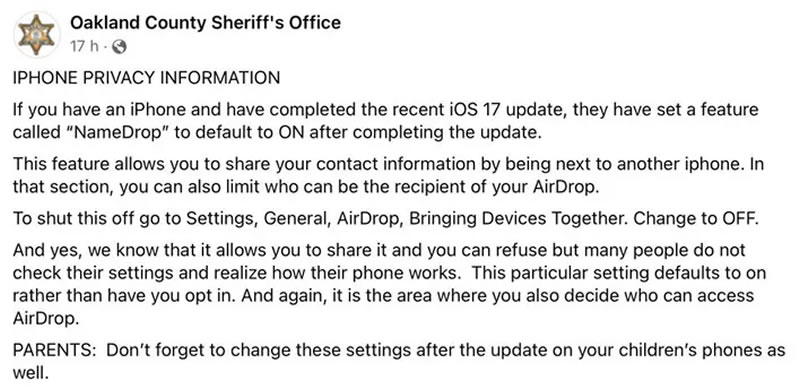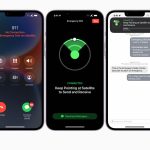In a move that has caught the attention of law enforcement agencies across the United States, Apple’s recent introduction of the NameDrop feature in iOS 17.1 raises concerns about potential security breaches, particularly about the safety of children. While Apple aims to streamline communication with this functionality reminiscent of AirDrop, numerous police departments assert that NameDrop may compromise the safety of minors.
The NameDrop Feature
With the rollout of iOS 17.1, Apple unveiled the NameDrop feature, allowing users to swiftly share contact information and photos among Apple devices in a manner akin to AirDrop. This feature operates by users bringing their device screens nearby and initiating a touch-based transfer. Although seemingly innocuous, several law enforcement agencies in the United States are sounding the alarm about the potential risks posed to children.

Law Enforcement Concerns
Law enforcement officials argue that the NameDrop feature, which facilitates the quick exchange of contact details, particularly poses a threat to individuals under 18. They emphasize the ease with which strangers could obtain and exchange phone numbers with minors, highlighting the potential for exploitation. Consequently, authorities are urging parents to disable the NameDrop feature to safeguard their children from potential risks.
The Connecticut Police Department’s Warning
One notable instance of this cautionary stance comes from a police department in Connecticut, which issued a warning via social media about the potential dangers associated with NameDrop. Some parents have expressed surprise, claiming they were unaware of the feature after updating their children’s devices. This discrepancy in awareness underscores the importance of educating parents about the potential risks linked to new features and updates.
While some parents remain unaware of the risks associated with NameDrop, all guardians must recognize the potential dangers posed by this feature. Law enforcement agencies stress the need for proactive measures to ensure the safety of minors, including staying informed about the functionalities of the devices their children use.
Apple’s Two-Step Verification Assurance
In response to these concerns, Apple asserts that NameDrop includes a two-step verification process. This means that both parties involved in a NameDrop exchange must actively participate in the verification process using their respective iPhones. Despite Apple’s reassurances, law enforcement agencies remain skeptical, emphasizing the unique risks associated with NameDrop, distinct from other sharing features like AirDrop.
Comparing Risks: NameDrop vs. AirDrop
While acknowledging that similar risks exist with AirDrop, it is essential to recognize the distinctive vulnerabilities posed by NameDrop. The ease with which NameDrop facilitates contact sharing raises concerns about potential misuse, particularly when it comes to minors interacting with strangers.
In Summary
As technology continues to evolve, so do the potential risks associated with new features. The introduction of the NameDrop feature in iOS 17.1 has sparked concerns among law enforcement agencies, particularly regarding the safety of children. Parents are strongly urged to familiarize themselves with these new functionalities and take proactive measures to ensure the digital safety of their children. As discussions around digital security and child protection continue, both technology companies and users need to address and mitigate potential risks collaboratively.










